Ebola Outbreak in West Africa: WHO's Emergency Response Analysis
VerifiedAdded on 2022/10/01
|8
|1853
|240
Report
AI Summary
This report analyzes the World Health Organization's (WHO) response to the 2014 Ebola outbreak in West Africa, examining the emergency management strategies employed. It details the WHO's three-phase response, focusing on scaling up resources, increasing capacities, and interrupting transmission chains. The report identifies public health needs in the affected countries, including infrastructure weaknesses, cultural beliefs, and economic challenges. It discusses global, local, and regional barriers faced by the WHO, such as coordination issues and inadequate resources. Collaborative arrangements between the WHO and other agencies like the Ministry of Health, AFRO, and MSF are explored, highlighting their role in identifying the outbreak's epicenter. The report evaluates the efficacy of the WHO's interventions, noting the successful control of the outbreak despite high fatality rates in some regions. It concludes by emphasizing the crucial role the WHO played in the public health emergency response, while also acknowledging that complete eradication is still pending.
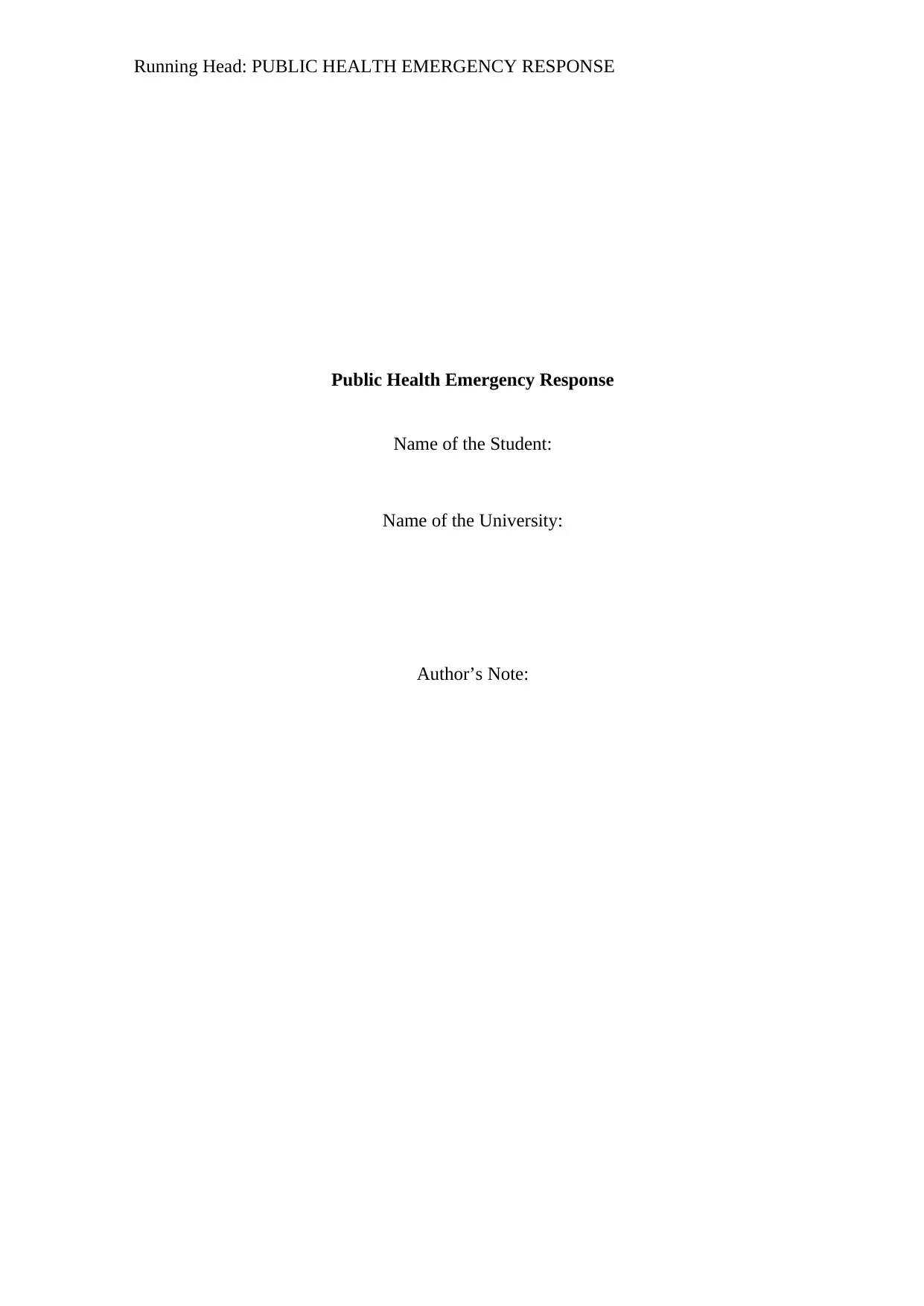
Running Head: PUBLIC HEALTH EMERGENCY RESPONSE
Public Health Emergency Response
Name of the Student:
Name of the University:
Author’s Note:
Public Health Emergency Response
Name of the Student:
Name of the University:
Author’s Note:
Paraphrase This Document
Need a fresh take? Get an instant paraphrase of this document with our AI Paraphraser
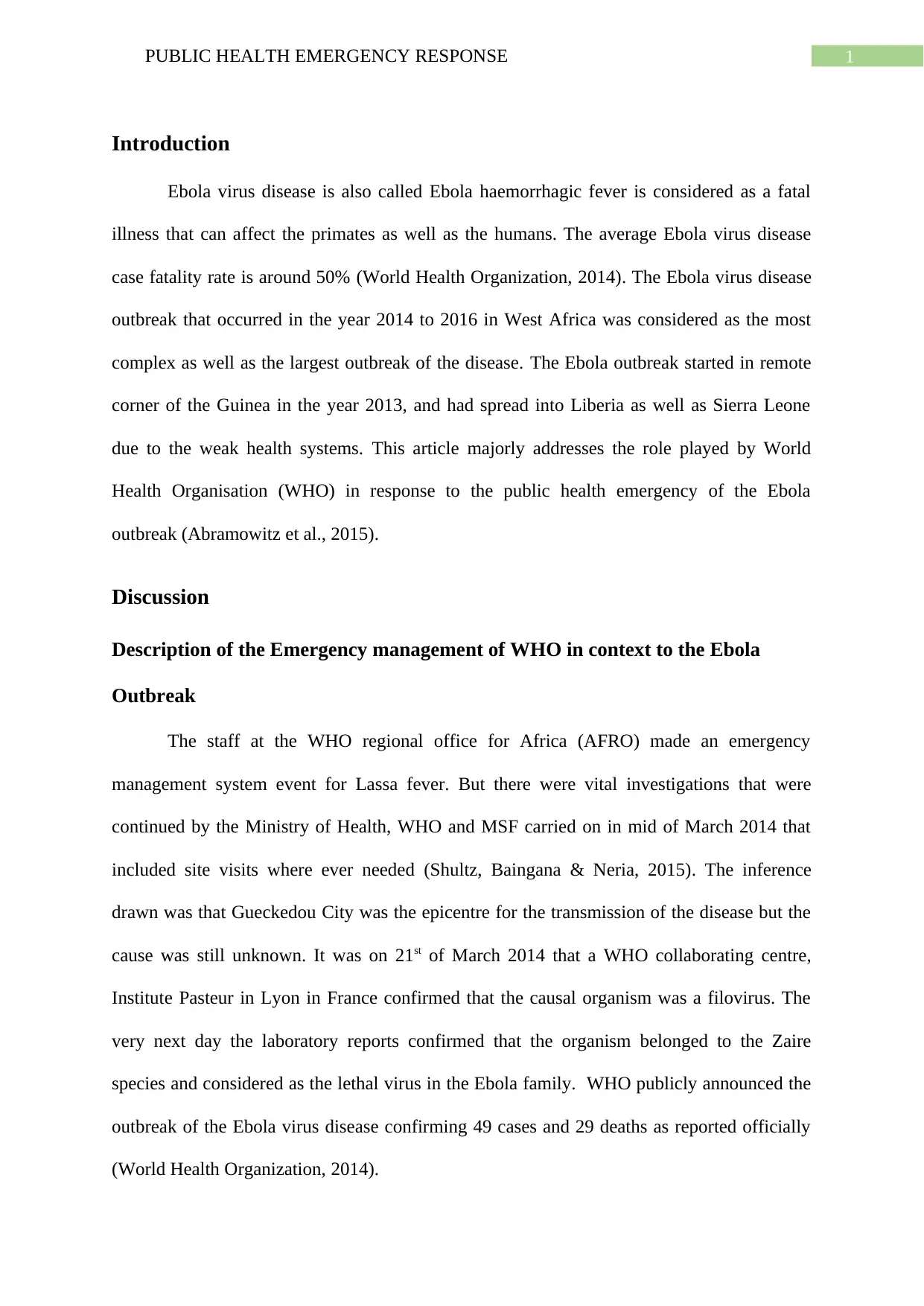
1PUBLIC HEALTH EMERGENCY RESPONSE
Introduction
Ebola virus disease is also called Ebola haemorrhagic fever is considered as a fatal
illness that can affect the primates as well as the humans. The average Ebola virus disease
case fatality rate is around 50% (World Health Organization, 2014). The Ebola virus disease
outbreak that occurred in the year 2014 to 2016 in West Africa was considered as the most
complex as well as the largest outbreak of the disease. The Ebola outbreak started in remote
corner of the Guinea in the year 2013, and had spread into Liberia as well as Sierra Leone
due to the weak health systems. This article majorly addresses the role played by World
Health Organisation (WHO) in response to the public health emergency of the Ebola
outbreak (Abramowitz et al., 2015).
Discussion
Description of the Emergency management of WHO in context to the Ebola
Outbreak
The staff at the WHO regional office for Africa (AFRO) made an emergency
management system event for Lassa fever. But there were vital investigations that were
continued by the Ministry of Health, WHO and MSF carried on in mid of March 2014 that
included site visits where ever needed (Shultz, Baingana & Neria, 2015). The inference
drawn was that Gueckedou City was the epicentre for the transmission of the disease but the
cause was still unknown. It was on 21st of March 2014 that a WHO collaborating centre,
Institute Pasteur in Lyon in France confirmed that the causal organism was a filovirus. The
very next day the laboratory reports confirmed that the organism belonged to the Zaire
species and considered as the lethal virus in the Ebola family. WHO publicly announced the
outbreak of the Ebola virus disease confirming 49 cases and 29 deaths as reported officially
(World Health Organization, 2014).
Introduction
Ebola virus disease is also called Ebola haemorrhagic fever is considered as a fatal
illness that can affect the primates as well as the humans. The average Ebola virus disease
case fatality rate is around 50% (World Health Organization, 2014). The Ebola virus disease
outbreak that occurred in the year 2014 to 2016 in West Africa was considered as the most
complex as well as the largest outbreak of the disease. The Ebola outbreak started in remote
corner of the Guinea in the year 2013, and had spread into Liberia as well as Sierra Leone
due to the weak health systems. This article majorly addresses the role played by World
Health Organisation (WHO) in response to the public health emergency of the Ebola
outbreak (Abramowitz et al., 2015).
Discussion
Description of the Emergency management of WHO in context to the Ebola
Outbreak
The staff at the WHO regional office for Africa (AFRO) made an emergency
management system event for Lassa fever. But there were vital investigations that were
continued by the Ministry of Health, WHO and MSF carried on in mid of March 2014 that
included site visits where ever needed (Shultz, Baingana & Neria, 2015). The inference
drawn was that Gueckedou City was the epicentre for the transmission of the disease but the
cause was still unknown. It was on 21st of March 2014 that a WHO collaborating centre,
Institute Pasteur in Lyon in France confirmed that the causal organism was a filovirus. The
very next day the laboratory reports confirmed that the organism belonged to the Zaire
species and considered as the lethal virus in the Ebola family. WHO publicly announced the
outbreak of the Ebola virus disease confirming 49 cases and 29 deaths as reported officially
(World Health Organization, 2014).
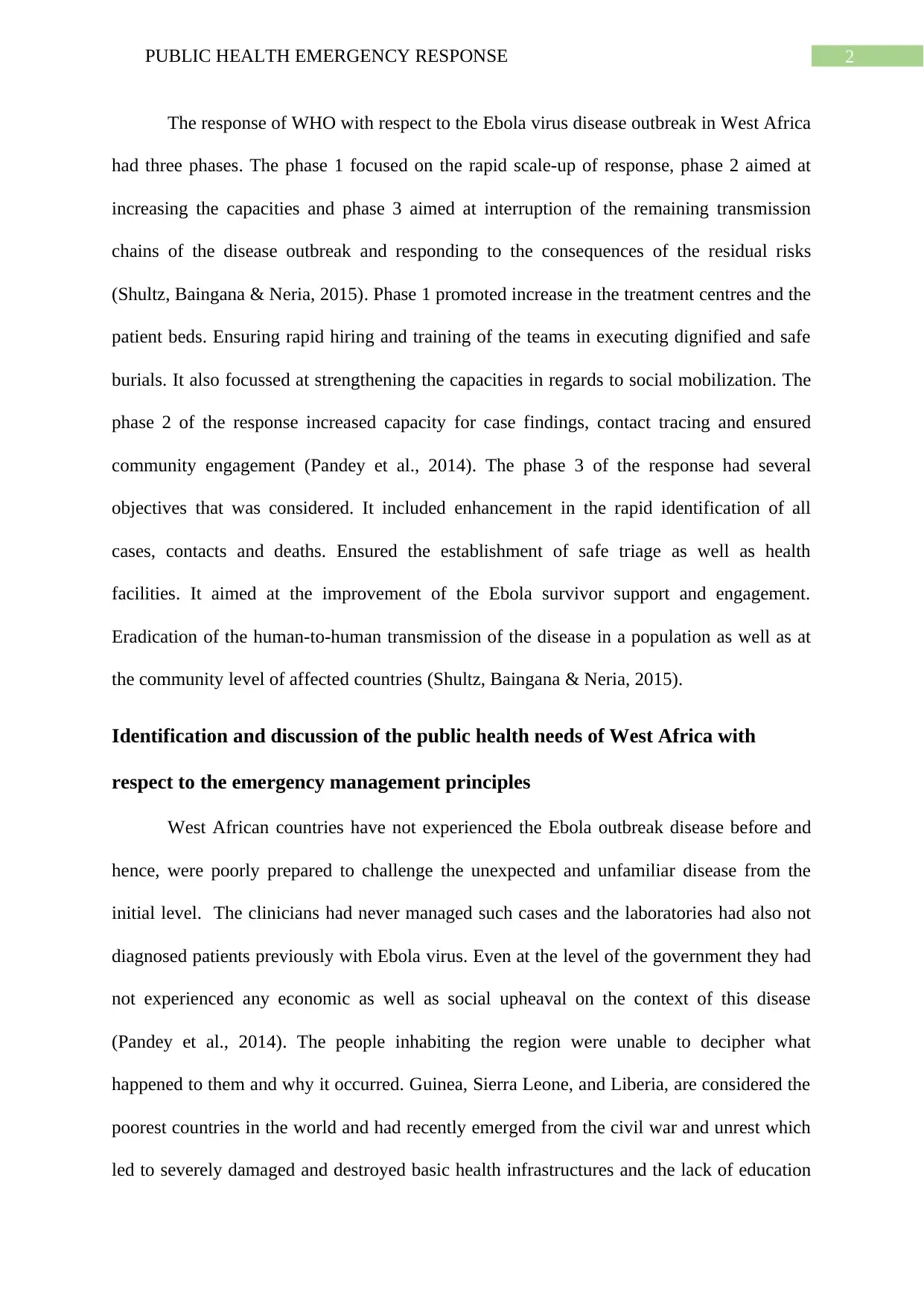
2PUBLIC HEALTH EMERGENCY RESPONSE
The response of WHO with respect to the Ebola virus disease outbreak in West Africa
had three phases. The phase 1 focused on the rapid scale-up of response, phase 2 aimed at
increasing the capacities and phase 3 aimed at interruption of the remaining transmission
chains of the disease outbreak and responding to the consequences of the residual risks
(Shultz, Baingana & Neria, 2015). Phase 1 promoted increase in the treatment centres and the
patient beds. Ensuring rapid hiring and training of the teams in executing dignified and safe
burials. It also focussed at strengthening the capacities in regards to social mobilization. The
phase 2 of the response increased capacity for case findings, contact tracing and ensured
community engagement (Pandey et al., 2014). The phase 3 of the response had several
objectives that was considered. It included enhancement in the rapid identification of all
cases, contacts and deaths. Ensured the establishment of safe triage as well as health
facilities. It aimed at the improvement of the Ebola survivor support and engagement.
Eradication of the human-to-human transmission of the disease in a population as well as at
the community level of affected countries (Shultz, Baingana & Neria, 2015).
Identification and discussion of the public health needs of West Africa with
respect to the emergency management principles
West African countries have not experienced the Ebola outbreak disease before and
hence, were poorly prepared to challenge the unexpected and unfamiliar disease from the
initial level. The clinicians had never managed such cases and the laboratories had also not
diagnosed patients previously with Ebola virus. Even at the level of the government they had
not experienced any economic as well as social upheaval on the context of this disease
(Pandey et al., 2014). The people inhabiting the region were unable to decipher what
happened to them and why it occurred. Guinea, Sierra Leone, and Liberia, are considered the
poorest countries in the world and had recently emerged from the civil war and unrest which
led to severely damaged and destroyed basic health infrastructures and the lack of education
The response of WHO with respect to the Ebola virus disease outbreak in West Africa
had three phases. The phase 1 focused on the rapid scale-up of response, phase 2 aimed at
increasing the capacities and phase 3 aimed at interruption of the remaining transmission
chains of the disease outbreak and responding to the consequences of the residual risks
(Shultz, Baingana & Neria, 2015). Phase 1 promoted increase in the treatment centres and the
patient beds. Ensuring rapid hiring and training of the teams in executing dignified and safe
burials. It also focussed at strengthening the capacities in regards to social mobilization. The
phase 2 of the response increased capacity for case findings, contact tracing and ensured
community engagement (Pandey et al., 2014). The phase 3 of the response had several
objectives that was considered. It included enhancement in the rapid identification of all
cases, contacts and deaths. Ensured the establishment of safe triage as well as health
facilities. It aimed at the improvement of the Ebola survivor support and engagement.
Eradication of the human-to-human transmission of the disease in a population as well as at
the community level of affected countries (Shultz, Baingana & Neria, 2015).
Identification and discussion of the public health needs of West Africa with
respect to the emergency management principles
West African countries have not experienced the Ebola outbreak disease before and
hence, were poorly prepared to challenge the unexpected and unfamiliar disease from the
initial level. The clinicians had never managed such cases and the laboratories had also not
diagnosed patients previously with Ebola virus. Even at the level of the government they had
not experienced any economic as well as social upheaval on the context of this disease
(Pandey et al., 2014). The people inhabiting the region were unable to decipher what
happened to them and why it occurred. Guinea, Sierra Leone, and Liberia, are considered the
poorest countries in the world and had recently emerged from the civil war and unrest which
led to severely damaged and destroyed basic health infrastructures and the lack of education
⊘ This is a preview!⊘
Do you want full access?
Subscribe today to unlock all pages.

Trusted by 1+ million students worldwide
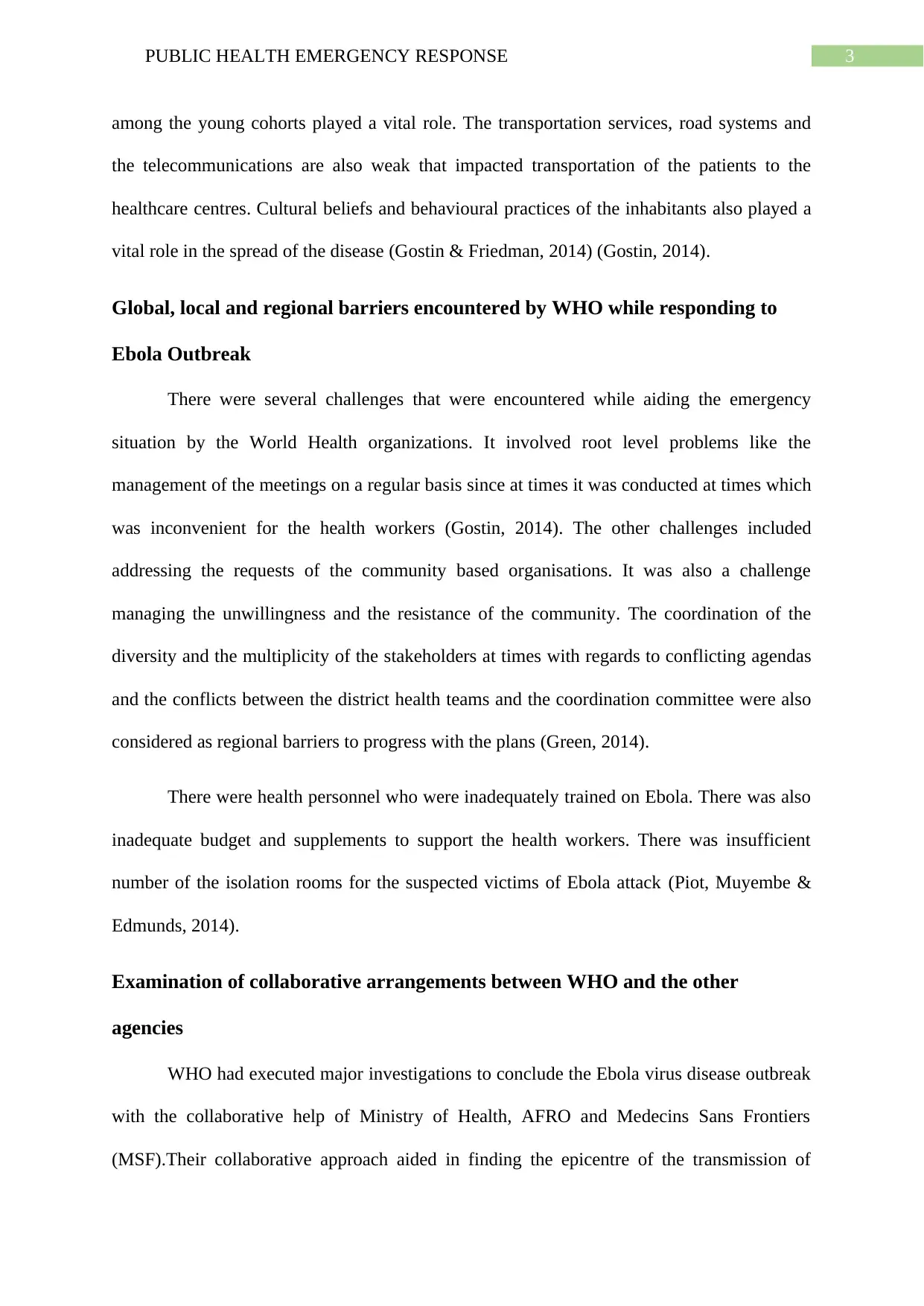
3PUBLIC HEALTH EMERGENCY RESPONSE
among the young cohorts played a vital role. The transportation services, road systems and
the telecommunications are also weak that impacted transportation of the patients to the
healthcare centres. Cultural beliefs and behavioural practices of the inhabitants also played a
vital role in the spread of the disease (Gostin & Friedman, 2014) (Gostin, 2014).
Global, local and regional barriers encountered by WHO while responding to
Ebola Outbreak
There were several challenges that were encountered while aiding the emergency
situation by the World Health organizations. It involved root level problems like the
management of the meetings on a regular basis since at times it was conducted at times which
was inconvenient for the health workers (Gostin, 2014). The other challenges included
addressing the requests of the community based organisations. It was also a challenge
managing the unwillingness and the resistance of the community. The coordination of the
diversity and the multiplicity of the stakeholders at times with regards to conflicting agendas
and the conflicts between the district health teams and the coordination committee were also
considered as regional barriers to progress with the plans (Green, 2014).
There were health personnel who were inadequately trained on Ebola. There was also
inadequate budget and supplements to support the health workers. There was insufficient
number of the isolation rooms for the suspected victims of Ebola attack (Piot, Muyembe &
Edmunds, 2014).
Examination of collaborative arrangements between WHO and the other
agencies
WHO had executed major investigations to conclude the Ebola virus disease outbreak
with the collaborative help of Ministry of Health, AFRO and Medecins Sans Frontiers
(MSF).Their collaborative approach aided in finding the epicentre of the transmission of
among the young cohorts played a vital role. The transportation services, road systems and
the telecommunications are also weak that impacted transportation of the patients to the
healthcare centres. Cultural beliefs and behavioural practices of the inhabitants also played a
vital role in the spread of the disease (Gostin & Friedman, 2014) (Gostin, 2014).
Global, local and regional barriers encountered by WHO while responding to
Ebola Outbreak
There were several challenges that were encountered while aiding the emergency
situation by the World Health organizations. It involved root level problems like the
management of the meetings on a regular basis since at times it was conducted at times which
was inconvenient for the health workers (Gostin, 2014). The other challenges included
addressing the requests of the community based organisations. It was also a challenge
managing the unwillingness and the resistance of the community. The coordination of the
diversity and the multiplicity of the stakeholders at times with regards to conflicting agendas
and the conflicts between the district health teams and the coordination committee were also
considered as regional barriers to progress with the plans (Green, 2014).
There were health personnel who were inadequately trained on Ebola. There was also
inadequate budget and supplements to support the health workers. There was insufficient
number of the isolation rooms for the suspected victims of Ebola attack (Piot, Muyembe &
Edmunds, 2014).
Examination of collaborative arrangements between WHO and the other
agencies
WHO had executed major investigations to conclude the Ebola virus disease outbreak
with the collaborative help of Ministry of Health, AFRO and Medecins Sans Frontiers
(MSF).Their collaborative approach aided in finding the epicentre of the transmission of
Paraphrase This Document
Need a fresh take? Get an instant paraphrase of this document with our AI Paraphraser
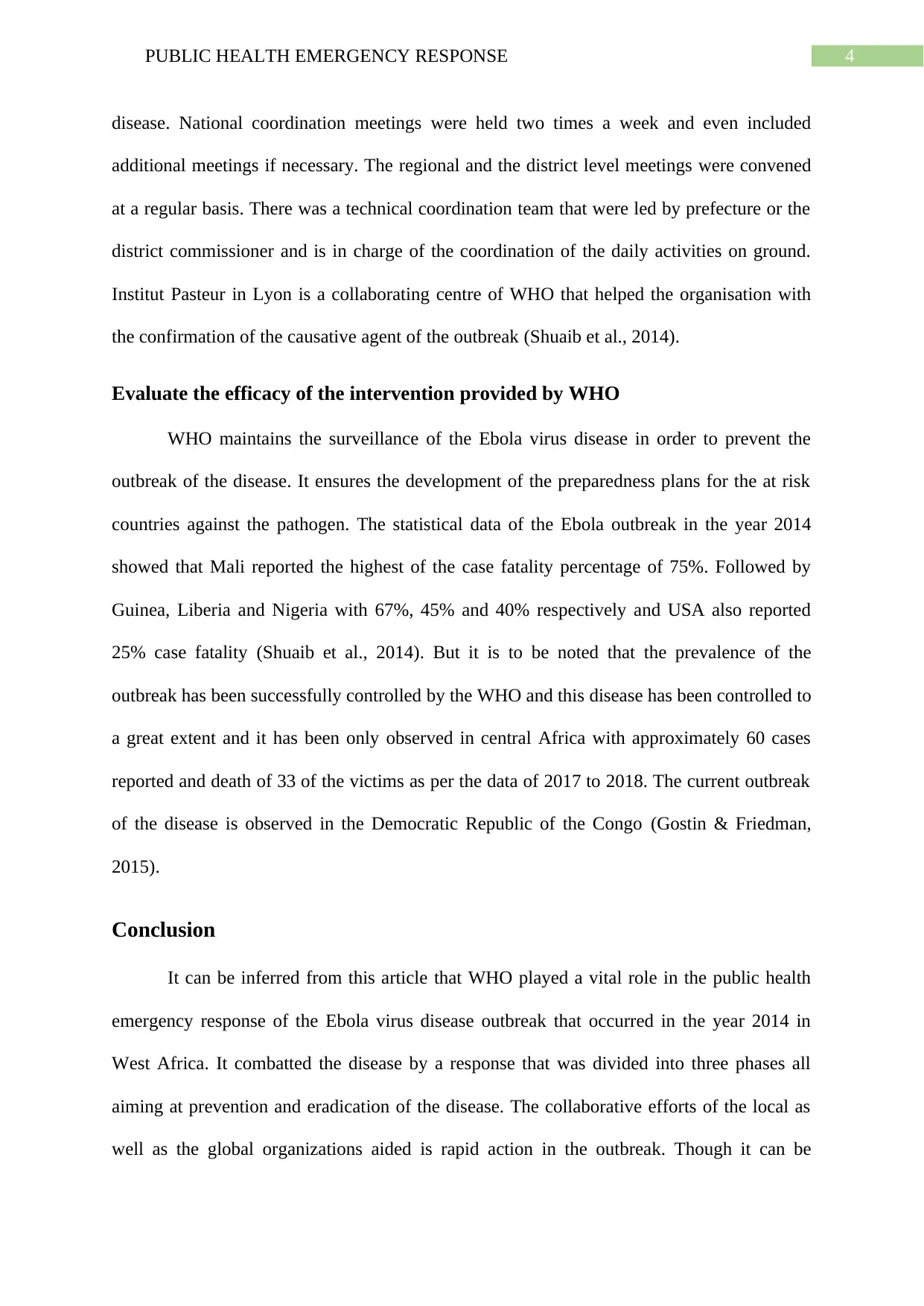
4PUBLIC HEALTH EMERGENCY RESPONSE
disease. National coordination meetings were held two times a week and even included
additional meetings if necessary. The regional and the district level meetings were convened
at a regular basis. There was a technical coordination team that were led by prefecture or the
district commissioner and is in charge of the coordination of the daily activities on ground.
Institut Pasteur in Lyon is a collaborating centre of WHO that helped the organisation with
the confirmation of the causative agent of the outbreak (Shuaib et al., 2014).
Evaluate the efficacy of the intervention provided by WHO
WHO maintains the surveillance of the Ebola virus disease in order to prevent the
outbreak of the disease. It ensures the development of the preparedness plans for the at risk
countries against the pathogen. The statistical data of the Ebola outbreak in the year 2014
showed that Mali reported the highest of the case fatality percentage of 75%. Followed by
Guinea, Liberia and Nigeria with 67%, 45% and 40% respectively and USA also reported
25% case fatality (Shuaib et al., 2014). But it is to be noted that the prevalence of the
outbreak has been successfully controlled by the WHO and this disease has been controlled to
a great extent and it has been only observed in central Africa with approximately 60 cases
reported and death of 33 of the victims as per the data of 2017 to 2018. The current outbreak
of the disease is observed in the Democratic Republic of the Congo (Gostin & Friedman,
2015).
Conclusion
It can be inferred from this article that WHO played a vital role in the public health
emergency response of the Ebola virus disease outbreak that occurred in the year 2014 in
West Africa. It combatted the disease by a response that was divided into three phases all
aiming at prevention and eradication of the disease. The collaborative efforts of the local as
well as the global organizations aided is rapid action in the outbreak. Though it can be
disease. National coordination meetings were held two times a week and even included
additional meetings if necessary. The regional and the district level meetings were convened
at a regular basis. There was a technical coordination team that were led by prefecture or the
district commissioner and is in charge of the coordination of the daily activities on ground.
Institut Pasteur in Lyon is a collaborating centre of WHO that helped the organisation with
the confirmation of the causative agent of the outbreak (Shuaib et al., 2014).
Evaluate the efficacy of the intervention provided by WHO
WHO maintains the surveillance of the Ebola virus disease in order to prevent the
outbreak of the disease. It ensures the development of the preparedness plans for the at risk
countries against the pathogen. The statistical data of the Ebola outbreak in the year 2014
showed that Mali reported the highest of the case fatality percentage of 75%. Followed by
Guinea, Liberia and Nigeria with 67%, 45% and 40% respectively and USA also reported
25% case fatality (Shuaib et al., 2014). But it is to be noted that the prevalence of the
outbreak has been successfully controlled by the WHO and this disease has been controlled to
a great extent and it has been only observed in central Africa with approximately 60 cases
reported and death of 33 of the victims as per the data of 2017 to 2018. The current outbreak
of the disease is observed in the Democratic Republic of the Congo (Gostin & Friedman,
2015).
Conclusion
It can be inferred from this article that WHO played a vital role in the public health
emergency response of the Ebola virus disease outbreak that occurred in the year 2014 in
West Africa. It combatted the disease by a response that was divided into three phases all
aiming at prevention and eradication of the disease. The collaborative efforts of the local as
well as the global organizations aided is rapid action in the outbreak. Though it can be
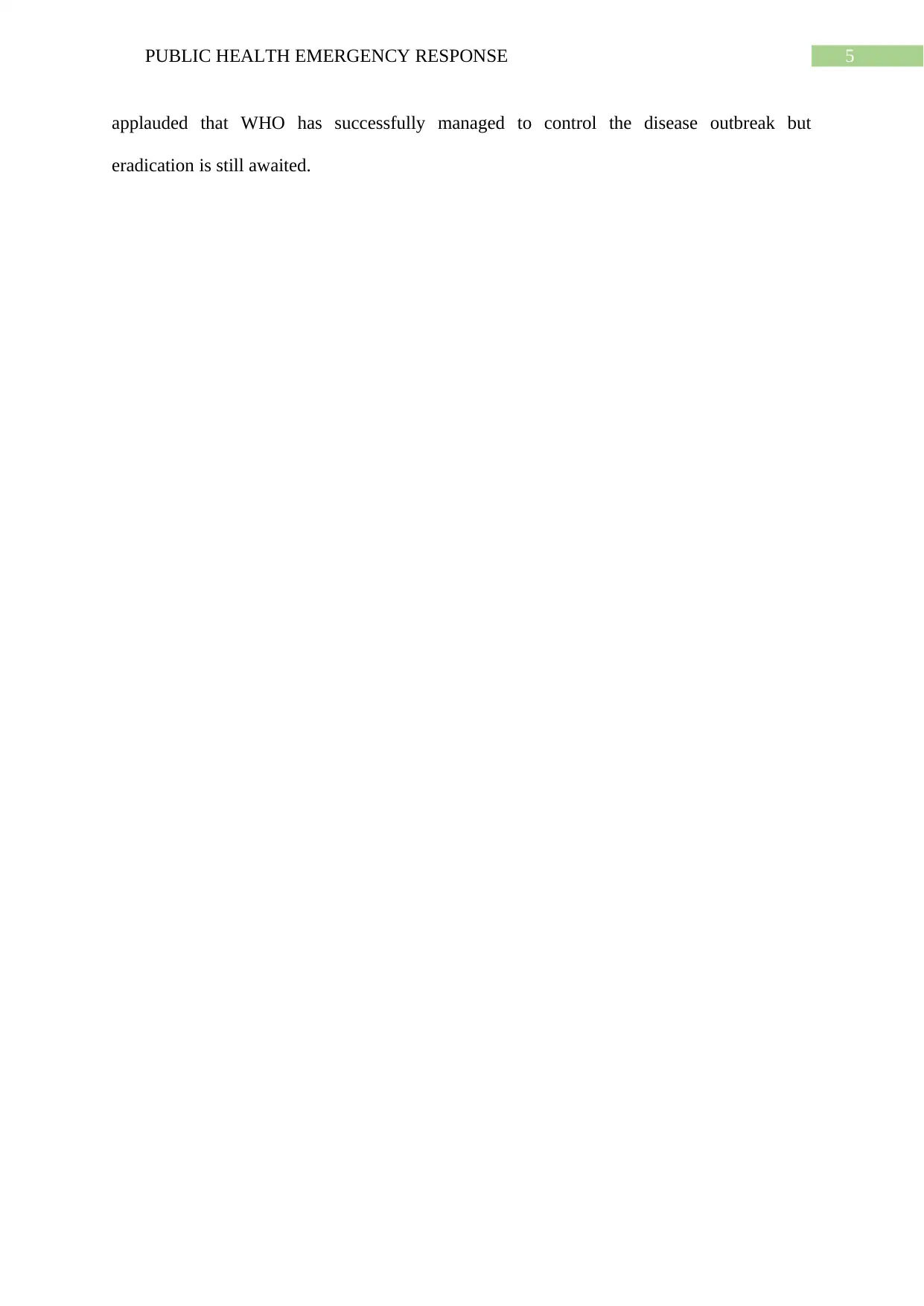
5PUBLIC HEALTH EMERGENCY RESPONSE
applauded that WHO has successfully managed to control the disease outbreak but
eradication is still awaited.
applauded that WHO has successfully managed to control the disease outbreak but
eradication is still awaited.
⊘ This is a preview!⊘
Do you want full access?
Subscribe today to unlock all pages.

Trusted by 1+ million students worldwide
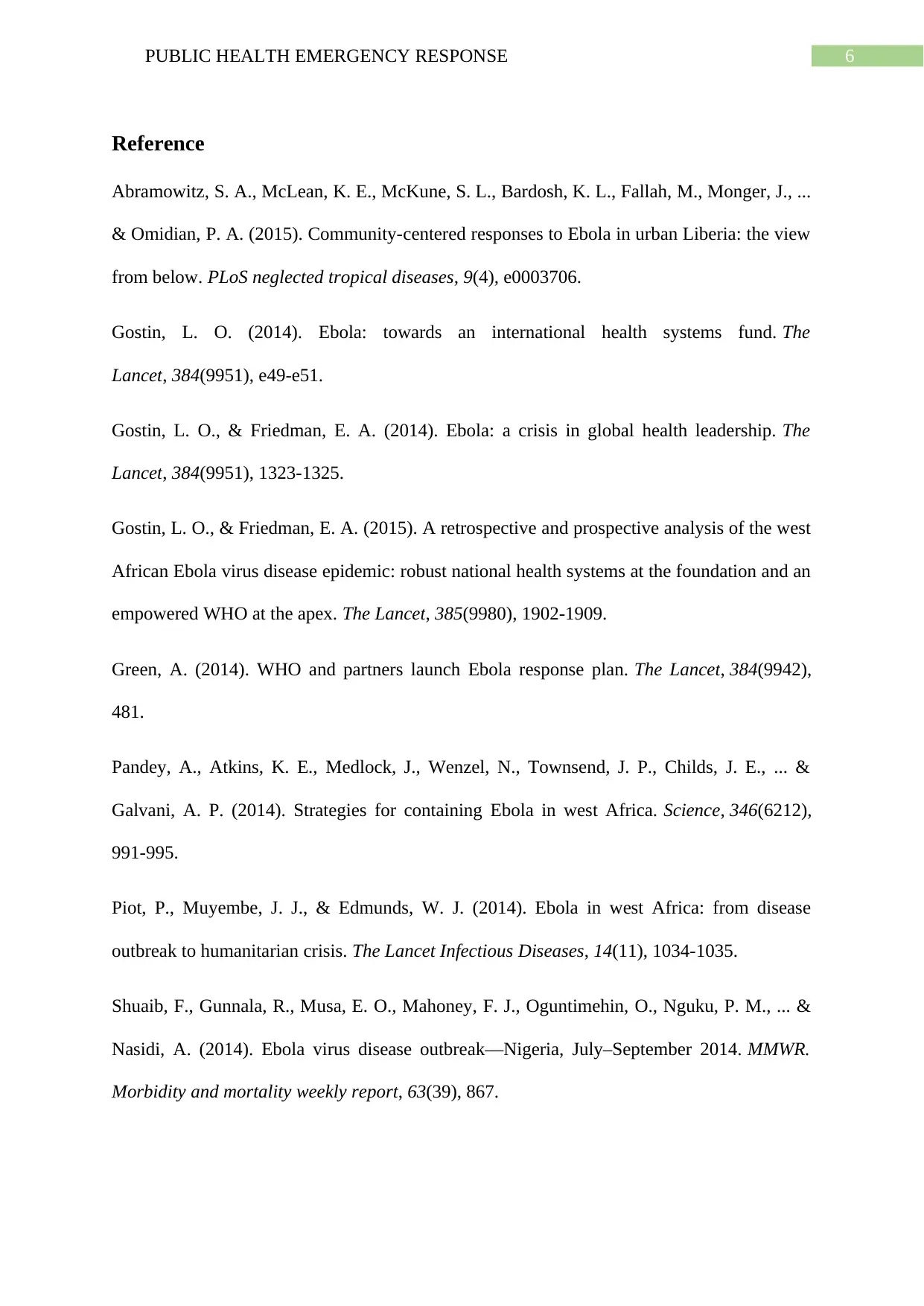
6PUBLIC HEALTH EMERGENCY RESPONSE
Reference
Abramowitz, S. A., McLean, K. E., McKune, S. L., Bardosh, K. L., Fallah, M., Monger, J., ...
& Omidian, P. A. (2015). Community-centered responses to Ebola in urban Liberia: the view
from below. PLoS neglected tropical diseases, 9(4), e0003706.
Gostin, L. O. (2014). Ebola: towards an international health systems fund. The
Lancet, 384(9951), e49-e51.
Gostin, L. O., & Friedman, E. A. (2014). Ebola: a crisis in global health leadership. The
Lancet, 384(9951), 1323-1325.
Gostin, L. O., & Friedman, E. A. (2015). A retrospective and prospective analysis of the west
African Ebola virus disease epidemic: robust national health systems at the foundation and an
empowered WHO at the apex. The Lancet, 385(9980), 1902-1909.
Green, A. (2014). WHO and partners launch Ebola response plan. The Lancet, 384(9942),
481.
Pandey, A., Atkins, K. E., Medlock, J., Wenzel, N., Townsend, J. P., Childs, J. E., ... &
Galvani, A. P. (2014). Strategies for containing Ebola in west Africa. Science, 346(6212),
991-995.
Piot, P., Muyembe, J. J., & Edmunds, W. J. (2014). Ebola in west Africa: from disease
outbreak to humanitarian crisis. The Lancet Infectious Diseases, 14(11), 1034-1035.
Shuaib, F., Gunnala, R., Musa, E. O., Mahoney, F. J., Oguntimehin, O., Nguku, P. M., ... &
Nasidi, A. (2014). Ebola virus disease outbreak—Nigeria, July–September 2014. MMWR.
Morbidity and mortality weekly report, 63(39), 867.
Reference
Abramowitz, S. A., McLean, K. E., McKune, S. L., Bardosh, K. L., Fallah, M., Monger, J., ...
& Omidian, P. A. (2015). Community-centered responses to Ebola in urban Liberia: the view
from below. PLoS neglected tropical diseases, 9(4), e0003706.
Gostin, L. O. (2014). Ebola: towards an international health systems fund. The
Lancet, 384(9951), e49-e51.
Gostin, L. O., & Friedman, E. A. (2014). Ebola: a crisis in global health leadership. The
Lancet, 384(9951), 1323-1325.
Gostin, L. O., & Friedman, E. A. (2015). A retrospective and prospective analysis of the west
African Ebola virus disease epidemic: robust national health systems at the foundation and an
empowered WHO at the apex. The Lancet, 385(9980), 1902-1909.
Green, A. (2014). WHO and partners launch Ebola response plan. The Lancet, 384(9942),
481.
Pandey, A., Atkins, K. E., Medlock, J., Wenzel, N., Townsend, J. P., Childs, J. E., ... &
Galvani, A. P. (2014). Strategies for containing Ebola in west Africa. Science, 346(6212),
991-995.
Piot, P., Muyembe, J. J., & Edmunds, W. J. (2014). Ebola in west Africa: from disease
outbreak to humanitarian crisis. The Lancet Infectious Diseases, 14(11), 1034-1035.
Shuaib, F., Gunnala, R., Musa, E. O., Mahoney, F. J., Oguntimehin, O., Nguku, P. M., ... &
Nasidi, A. (2014). Ebola virus disease outbreak—Nigeria, July–September 2014. MMWR.
Morbidity and mortality weekly report, 63(39), 867.
Paraphrase This Document
Need a fresh take? Get an instant paraphrase of this document with our AI Paraphraser
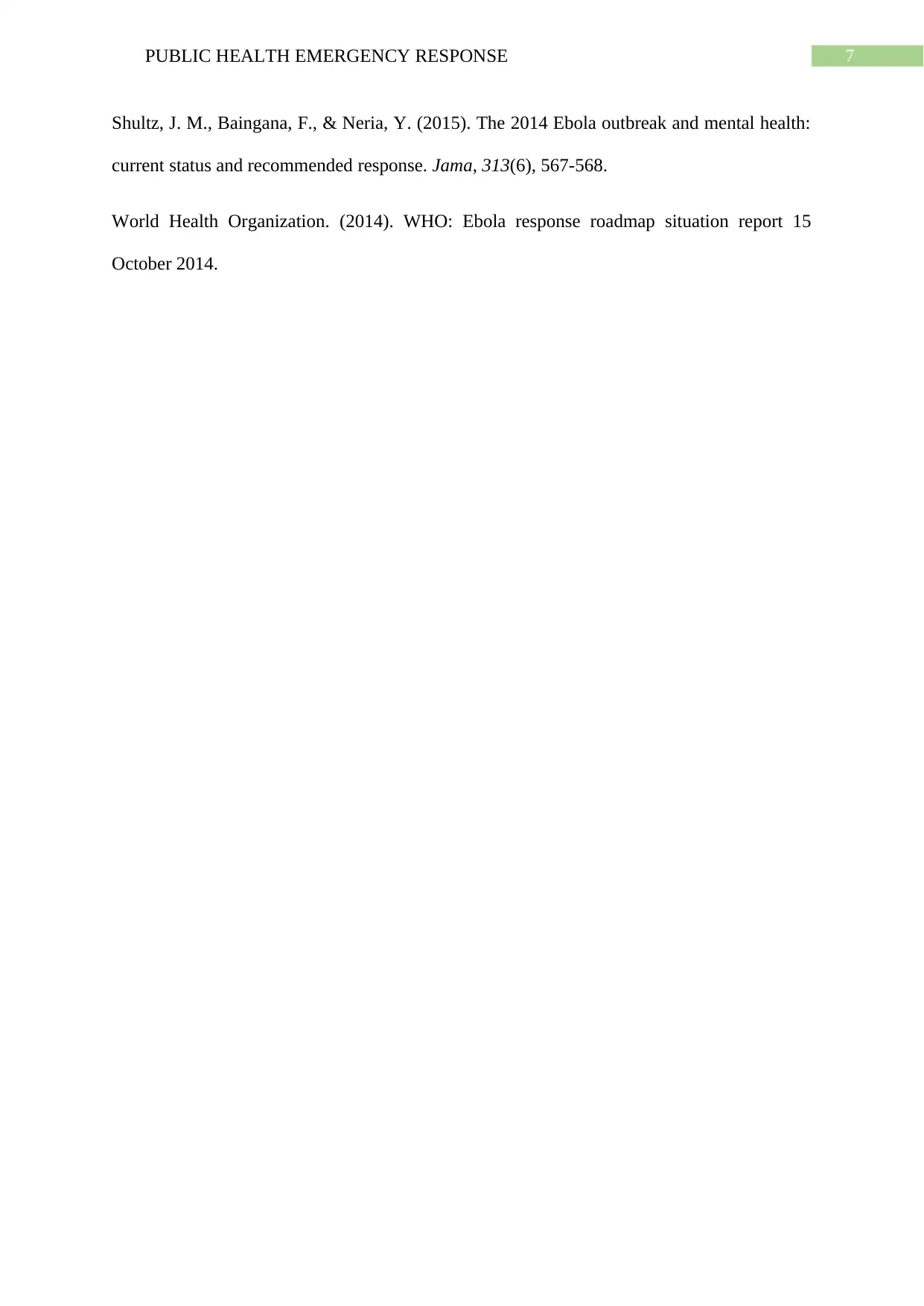
7PUBLIC HEALTH EMERGENCY RESPONSE
Shultz, J. M., Baingana, F., & Neria, Y. (2015). The 2014 Ebola outbreak and mental health:
current status and recommended response. Jama, 313(6), 567-568.
World Health Organization. (2014). WHO: Ebola response roadmap situation report 15
October 2014.
Shultz, J. M., Baingana, F., & Neria, Y. (2015). The 2014 Ebola outbreak and mental health:
current status and recommended response. Jama, 313(6), 567-568.
World Health Organization. (2014). WHO: Ebola response roadmap situation report 15
October 2014.
1 out of 8
Related Documents
Your All-in-One AI-Powered Toolkit for Academic Success.
+13062052269
info@desklib.com
Available 24*7 on WhatsApp / Email
![[object Object]](/_next/static/media/star-bottom.7253800d.svg)
Unlock your academic potential
Copyright © 2020–2025 A2Z Services. All Rights Reserved. Developed and managed by ZUCOL.





